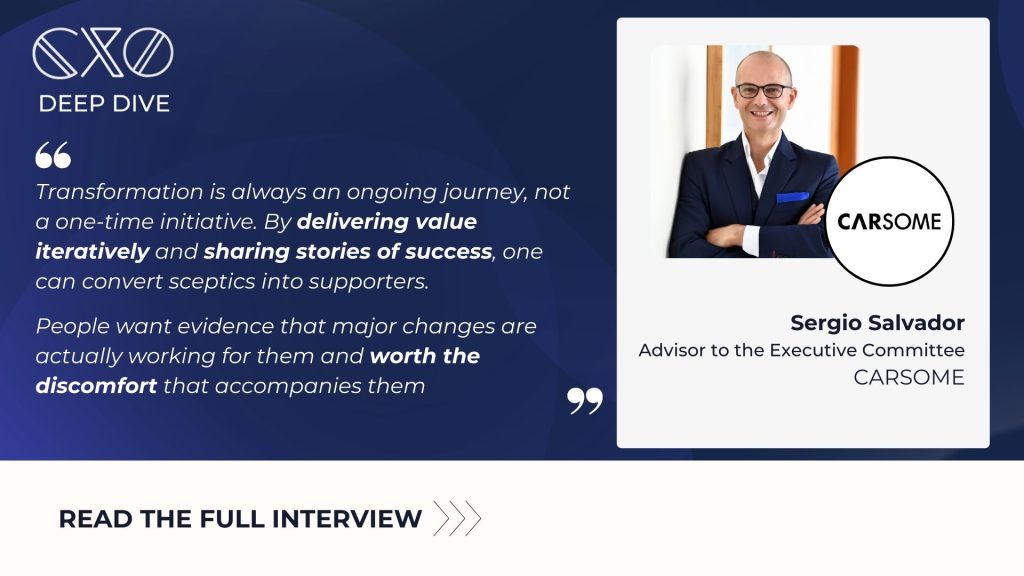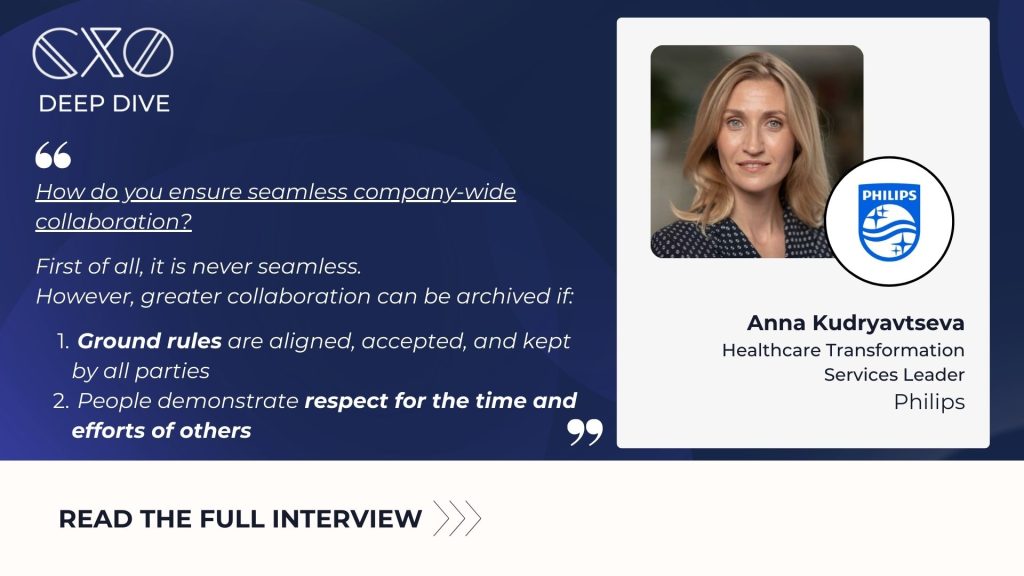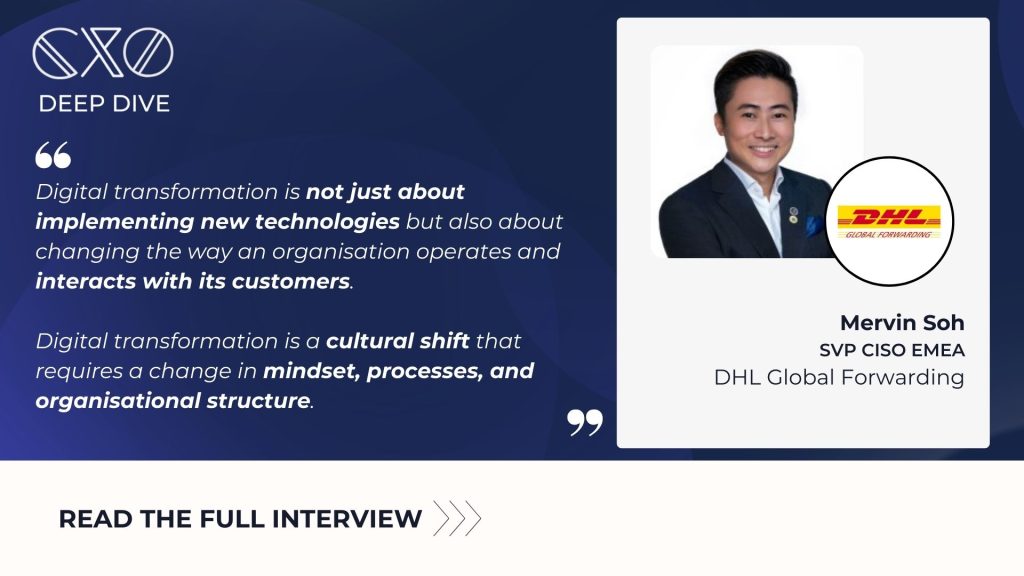Patricia Mulles, Director at M & O Consulting and Global Head of Partnerships at She Loves Data shares her insights and experiences on Transformation Strategy, Transformative Leadership & Technologies as part of the CXO Deep Dive series.
How would you explain your job to a 5-year-old?
I talk to companies around the world so they can help us pay for activities offered to women for FREE:
- Upskilling workshops that help more women learn more about data, digital and AI (and earn certificates);
- Mentoring programs where they can get practical career advice from more experienced men and women;
- Essential skills training, so women can have the right soft skills and leadership skills for work and life ;
- Networking activities where women can meet and bond with other women; and
- Hiring events – where we can help our data-trained women get jobs.
These are all done so there can be more of us leading in those spaces in the future. Our vision and mission are important – that girls and women have a say in driving the future of data and AI. The world’s progress depends on it.
[The World Economic Forum says more women working will increase global GDP by 19%!]
“There is no digital transformation, just transformation.” Do you agree or not? Why?
Our world, and consequently, our organisations, are continuously evolving, and faster than ever, thanks to technology and the market conditions that they create. If I could, I wouldn’t call it transformation or digital transformation, but Endless Evolution. The persistence of markets and technological innovation will keep driving the need to change constantly. There is no final stage like in a metamorphosis.
My point is, we need to shift mindsets so “transformation” efforts are no longer seen as having set end dates. This mental shift will allow people to adapt better to change, and that’s powerful. We’ll just need to sort out new financial models for supporting endless evolutions, to ensure scalable progress and profit.
What are the top challenges in your business transformation process?
It’s always about culture and people. People are the most volatile variables in a transformation (evolution) equation. Business transformation (evolution) requires the buy-in of most, if not all, stakeholders. From my experience, resistance from one or a few can spell the end of a project, or it can get the green light, but aspects of it will be blocked or move more slowly.
“It’s crucial to deliver and communicate benefits fast, to build momentum and confidence in transformation projects where there might be scepticism.” Do you agree? Or you have other thoughts on the timeline of a transformation project?
As mentioned earlier, a mind shift to “endless evolution” can put people in experimental mode or an understanding that today’s wins and failures all translate to learning for the next, future phase of the continuous evolution.
There is no such thing as an ensured success for business transformation projects.
Put simply, an organisation in transformation or endless evolution mode is like a giant AI that feeds off all of its efforts, as long as they are accurately recorded as data points and processed well. Ultimately this “people’s intelligence”, processed and augmented by AI, can potentially spit out insights and prescriptions that lead to less errors, higher efficiency rates and scalable successes.
Do you see transformation as a distinct skillset, best delivered by “Transformation Experts”, or is it better to be led by the core business?
I think that every person in an organisation should be primed for transformation (or better yet, Endless Evolution). This is the only way they can bake continuous process changes into their systems.
Having said that, experts, both internal and external, are still required for helping to set up strategies, digital platforms and processes. We need internal people who are minding the full picture 24/7, as well as external experts who can look at efforts with fresher eyes since they are not too close to it. All perspectives are necessary.
How do you pick the right partners to accelerate digital transformation?
It all depends on individual organisations and their objectives. The financial model will dictate expectations, given available resources. They need to be realistic.
What aspect(s) of business should organisations prioritise during digital transformation? Why?
People first. Get all stakeholders aligned on the need for transformation. Then, prioritisation of objectives gives a realistic assessment of resources that can be applied (cost-benefit and lifetime value). Processes need to be reviewed, and only then investigate technologies that can improve the processes, given the clearly communicated common objectives.
What is the best way to incorporate agile ways of working to accelerate transformation?
The best way depends on the objective balanced against available resources at a particular time.
From experience, agility can be enabled by the right technologies. However, having people willing to use these technologies and also put accurate data back into the platforms, is as crucial. The latter can only be achieved if people are accepting of the need and urgency for utilising said platforms.
People will be willing if they are trained well on the use of the platform in addition to understanding that “feeding the system” through constant use will lead to efficiencies in their jobs, and true endless evolution.
How do you achieve successful change management and shifts in culture, mindset and behaviours to adopt new digital tools?
This needs to be done in stages, with all leaders aligned on the steps and the “scripts” for enabling them.
- Align everyone on the need for transformation.
- Establish the mindset that evolution takes time and is continuous – Endless Evolution.
- Communicate clearly and enable constant feedback.
Stakeholders will have higher chances of buy in if these questions are addressed satisfactorily:
- “Is it really necessary for me to do/use this for me and the business to succeed? Demonstrate (job-specific) proof.”
- “Will this make me do my work faster and easier?”
- “Are the systems and tools easy to understand and learn? Will I get continuous training and tech support?”
- “Are there clear policies on privacy and ethics (data governance)?”
What do you ultimately do with people that do not want to change?
As long as the need for change is clearly communicated, changing minds should be done over time.
If some employees are still stubbornly resistant to change, despite efforts to train and explain, their concerns should still be heard and addressed (if reasonable), to avoid any blind spots.
HR or talent acquisition processes should also ensure that future hires have: a high tolerance for change and ambiguity, and are adaptable and open-minded.
How do you keep pace with rapid obsolescence in technology? How do you figure out stuff that will be relevant from a future perspective and have longevity from an investment perspective?
It is difficult, but one must always be listening and learning. This means always talking to a network of domain experts and leaders, subscribing to relevant technology and business newsletters and always listening to people regarding the needs of the organisation.
What technologies will surely impact the business world & our daily life in 2024 / 2025? Generative AI, Metaverse, Web 3.0, IoT, 5G / 6G or others?
Generative AI will and is already impacting business in a huge way, as the general public is made conscious of AI’s power. Combining this with quantum computing, philosophically more open environments like Web 3.0 and extremely fast networks like 6G will make the pace of change (in life and work) even more frenetic. Our ability to keep up with the speed of innovation will make or break the future of humanity.
How is your industry preparing for an AI-Centric world?
As a transformation or Endless Evolution Consultant, I help by educating my clients about the importance of developing an evolution-forward culture.
As Director and Global Partnerships Head for She Loves Data, we help provide free upskilling and career opportunities to women so they will have a chance to co-drive an AI-informed future.
Do you see automation as a path to drive operational efficiencies and ultimately save cost?
It is one path, yes. But investment and implementation should be thoughtful, with prior consultations with actual users. That is, not the very old style of “build first, question later.” We have already established that people determine the success of transformation projects, not technologies.
What are the challenges your organisation faces on people up-skilling, which becomes one of the basic need to drive complex transformation?
The most commonly cited reason for not engaging in upskilling projects even if it can clearly benefit participants is “lack of time.” Managers need to make training as important as the job. Often what happens is training is de-prioritised because they are scheduled after work hours to an already over-worked workforce. Incorporating training into the week’s work schedule will make it less of a chore. Also, companies should consider designing training courses by job type, rather than offering company-wide courses that often have no use context. Sufficient follow-through and always-on support from course providers will also help upskilling efforts more successfully. Lastly, getting the right partners that understand the training brief is paramount – avoid those that treat trainees as assembly line pupils.
What are the typical aspects that undermine a transformation position?
Lack of buy-in due to: a misunderstanding of processes or people’s needs, an overly ambitious project targeted more at superiors than the people implementing and benefiting from them, unrealistic goals especially with regard to available resources and time, unclear or bad communication of the whys and hows of transformation, too rigid goal posts, lack of commitment to training.
What other aspects during transformation needs to be addressed beyond digital competence?
Essential skills and leadership training are as crucial. Ensuring people have the right mindset will make them more receptive and trusting of the efforts.
Do you have any advice on how to create an environment for employees to share more?
Building trust between leaders and employees. Executives and HR must make the other mindset shift — from “systems for control” to “systems for collaboration.” Humanising processes and systems as reflected in how tools reward or penalise their users will be important. Management should agree on a “philosophical approach to a build” before entrusting everything to the technologists.
What’s the best advice someone has ever given you regarding transformation?
Don’t fixate on the technology no matter how sexy it may seem.
Focus on people use cases, and actual impact.
A big thank you to Patricia for sharing her insights and experiences on Transformation Strategy, Transformative Leadership & Technologies!
Visit our content library for more insights from the CXOs: https://cxoinnovation.com/content-library/
Join our LinkedIn CXO Community.





